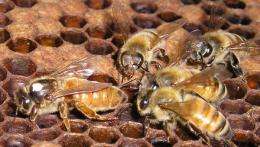Bees dance the light fantastic

Honeybees use a pattern of light in the sky invisible to humans to direct one another to a honey source, scientists have found.
Researchers at the Vision Centre have demonstrated that even on days when the sun doesn't shine, bees can navigate to and from a honey source by reading the pattern of polarised light in the sky and then explain to other bees where to find it with their 'waggle dance'.
"It basically means the bees tell each other where the nectar is by converting their polarised 'light map' into dance movements," explains Professor Mandyam Srinivasan of the VC and Queensland Brain Institute.
The discovery throws fresh light on the astonishing navigational and communication skills of an insect with a brain the size of a pinhead – but also on some of the most basic machinery of the brain itself.
"The more we find out how honeybees make their way around the landscape, the more awed we feel at the elegant way they solve very complicated problems of navigation that would floor most people – and then communicate them to other bees," he says.
"It is well known that bees steer by the sun, adjusting their compass as it moves across the sky, and then convert that information into instructions for other bees by waggling their body to signal the direction of the honey.
"It is also known that bees can find the honey source even on cloudy days when the sun isn't visible.
"Other laboratories have shown from studying their eyes that bees can see a pattern of polarised light in the sky even when the sun isn't shining: the big question was could they translate the navigational information it provides into their waggle dance."
The researchers flew bees down a tunnel to a sugar source, shining only polarised light from above on them – the sun was not visible. Sometimes the polarised light was aligned with the tunnel, sometimes it was at right angles to the tunnel. They then filmed what the bees 'told' their fellows when they got back to the hive, by waggling their bodies.
"When the polarised light was across the tunnel, the bees danced in a mainly vertical direction with upward and downward waggles. This told their mates to fly in a direction perpendicular to the direction of the polarised light in the sky. If the sun were visible in the sky, this would mean flying either directly toward the sun, or directly away from it.
"When the polarised light was in line with the tunnel, the bees danced in a horizontal direction with waggles to the left or right. This informed the other bees that they should fly along the direction of the polarised skylight. If the sun were visible, this would imply flying 90 degrees to the right or left of it.
The problem with using polarised light to steer by is that there are two opposite directions you can steer. The bees appear to deal with this problem by communicating both options to their colleagues. Two options are a lot more efficient than searching all over the landscape - and better than arbitrarily signalling just one of the two options, which may turn out to be the wrong one, he says.
"When we shone polarised light that was across in the first part of the tunnel and in-line in the second part, we simulated for the bees an L-shaped journey in which they flew initially in a direction perpendicular to the sun (either to the left or to the right of it) and later along the direction of the sun (either towards or away from it). This created the dilemma that the food source could be in one of four possible locations. The bees addressed this dilemma by informing their nest mates to search in all four possible directions."
The researchers conclude that even when the sun isn't shining bees can tell one another where to find food by reading and dancing to their polarised sky map.
Besides revealing how bees perform their remarkable tasks, the researchers say it may throw new light on how very simple brains work. When the light is aligned to the tunnel, it activates two 'place cells' in the insect's brain. When the light is across the tunnel, it activates two other cells. From these four cells the bee can work out if the food source lies north-south or east-west of the hive, they conjecture.
"We conclude that flying bees are capable of obtaining and signalling compass information that is derived purely from polarised light. Furthermore, they deal with the directional ambiguity that is inherent in polarised light by signalling all of the possible locations of the food source in their dances, thus maximising the chances of recruitment to it," the researchers conclude.
More information: C. Evangelista, P. Kraft, M. Dacke, T. Labhart, and M. V. Srinivasan. "Honeybee navigation: critically examining the role of the polarization compass." Phil. Trans. R. Soc. B February 19, 2014 369 1636 20130037; DOI: 10.1098/rstb.2013.0037 1471-2970
Provided by The ARC Centre of Excellence in Vision Science




















